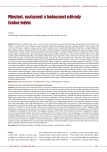Biological treatment following renal transplantation
Authors:
O. Viklický
Authors‘ workplace:
Klinika nefrologie, Transplantační centrum IKEM Praha, přednosta prof. MUDr. Ondřej Viklický, CSc.
Published in:
Vnitř Lék 2011; 57(7&8): 650-653
Category:
136th internal medicine day, XXIV. Vanýskův den, Brno 2011
Overview
Renal transplantation represents a method of choice in irreversible renal failure. The outcome of renal transplantation is affected by acute or chronic rejection and long-term evaluation also suggest a role of adverse effects of immunosuppressive therapy, mainly the incidence of cardiovascular complications and tumours. Immunosuppressive therapy with biologic agents aims to reduce the incidence of acute rejections, prolong allograft survival and, consequently, patient survival. Apart from a reduction in acute rejection incidence, biological agents are used in a selected group of patients to eliminate the need for an adjunctive treatment with steroids and to reduce consequences of ischemic-reperfusion damage in older donors who suffer from a range of co-morbidities. The most frequently used therapies include induction and anti-rejection therapy with a rabbit polyclonal anti-human thymocyte globulin (rATG) or an induction therapy with monoclonal anti-interleukin-2 receptor antibody (anti-IL2R), basiliximab. Considering the high immunosuppressive effect of rATG, adverse effects, mainly opportunistic infections and more frequent delayed tumourigenesis, have to be taken into account.
Key words:
ATG – basiliximab – renal transplantation – rejection
Sources
1. Brennan DC, Daller JA, Lake KD et al. Thymoglobulin Induction Study Group. Rabbit antithymocyte globulin versus basiliximab in renal transplantation. N Engl J Med 2006; 355 : 1967–1977.
2. Cruzado JM, Bestard O, Grinyó JM. New immunosuppressive protocols with the advent of novel biological drugs. Transplantation 2009; 88 (3 Suppl): S20–S23.
3. Ekberg H, Tedesco-Silva H, Demirbas A et al. ELITE – Symphony Study. Reduced exposure to calcineurin inhibitors in renal transplantation. N Engl J Med 2007; 357 : 2562–2575.
4. Fuchinoue S, Ishii Y, Sawada T et al. The 5-Year Outcome of ABO-Incompatible Kidney Transplantation With Rituximab Induction. Transplantation 2011; 91 : 853–857.
5. Jordan SC, Toyoda M, Kahwaji J et al. Clinical aspects of intravenous immunoglobulin use in solid organ transplant recipients. Am J Transplant 2011; 11 : 196–202.
6. Kidney Disease: Improving Global Outcomes (KDIGO) Transplant Work Group. KDIGO clinical practice guideline for the care of kidney transplant recipients. Am J Transplant 2009; 9 (Suppl 3): S1–S155.
7. Larsen CP, Pearson TC, Adams AB et al. Rational development of LEA29Y (belatacept), a high-affinity variant of CTLA4-Ig with potent immunosuppressive properties. Am J Transplant 2005; 5 : 443–453.
8. McKeage K, McCormack PL. Basiliximab: a review of its use as induction therapy in renal transplantation. BioDrugs 2010; 24 : 55–76.
9. Padiyar A, Augustine JJ, Hricik DE. Induction antibody therapy in kidney transplantation. Am J Kidney Dis 2009; 54 : 935–944.
10. Préville X, Flacher M, LeMauff B et al. Mechanisms involved in antithymocyte globulin immunosuppressive activity in a nonhuman primate model. Transplantation 2001; 71 : 460–468.
11. Vincenti F, Blancho G, Durrbach A et al. Five-year safety and efficacy of belatacept in renal transplantation. J Am Soc Nephrol 2010; 21 : 1587–1596.
12. Vo AA, Lukovsky M, Toyoda M et al. Rituximab and intravenous immune globulin for desensitization during renal transplantation. N Engl J Med 2008; 359 : 242–251.
Labels
Diabetology Endocrinology Internal medicineArticle was published in
Internal Medicine

2011 Issue 7&8
Most read in this issue
- Haemodialysis – the current practice
- Anemia and chronic kidney failure
- Immunosuppressive therapy and its problems
- Aetiology and a clinical picture of chronic renal failure
